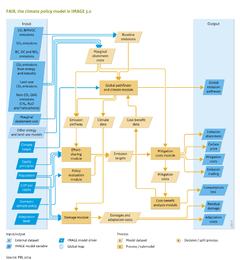Climate policy: Difference between revisions
Jump to navigation
Jump to search
No edit summary |
No edit summary |
||
| Line 4: | Line 4: | ||
|Status=On hold | |Status=On hold | ||
|IMAGEComponent=Scenario drivers; Emissions; Energy supply; Energy conversion; Energy supply and demand; Vegetation, hydrology and agriculture; Atmospheric composition and climate; | |IMAGEComponent=Scenario drivers; Emissions; Energy supply; Energy conversion; Energy supply and demand; Vegetation, hydrology and agriculture; Atmospheric composition and climate; | ||
|ExternalModel=MAGICC model; | |ExternalModel=MAGICC model; AD_RICE model | ||
|KeyReference=Den Elzen et al., 2011a; Den Elzen et al., 2008; Hof et al., 2008; Van Vliet et al., 2009; | |KeyReference=Den Elzen et al., 2011a; Den Elzen et al., 2008; Hof et al., 2008; Van Vliet et al., 2009; | ||
|InputVar=Population per Region; GDP per capita; CO2, other GHG, CO, NMVOC emissions; Marginal abatement cost; Climate policies; Marginal abatement cost; | |InputVar=Population per Region; GDP per capita; CO2, other GHG, CO, NMVOC emissions; Marginal abatement cost; Climate policies; Marginal abatement cost; | ||
Revision as of 16:41, 18 December 2013
| Component is implemented in: |
|
| Related IMAGE components |
| Models/Databases |
| Key publications |
| References |
Key policy issues
- What global greenhouse gas emissions pathways would meet the well below 2 °C climate target?
- What is the effect of effort-sharing approaches on regional and national emission reduction targets and on the cost of climate policies?
- What is the effect of the NDCs on achieving the long term 2 ºC target?
- What are the trade-offs between mitigation costs, adaptation costs, and climate change damage?
